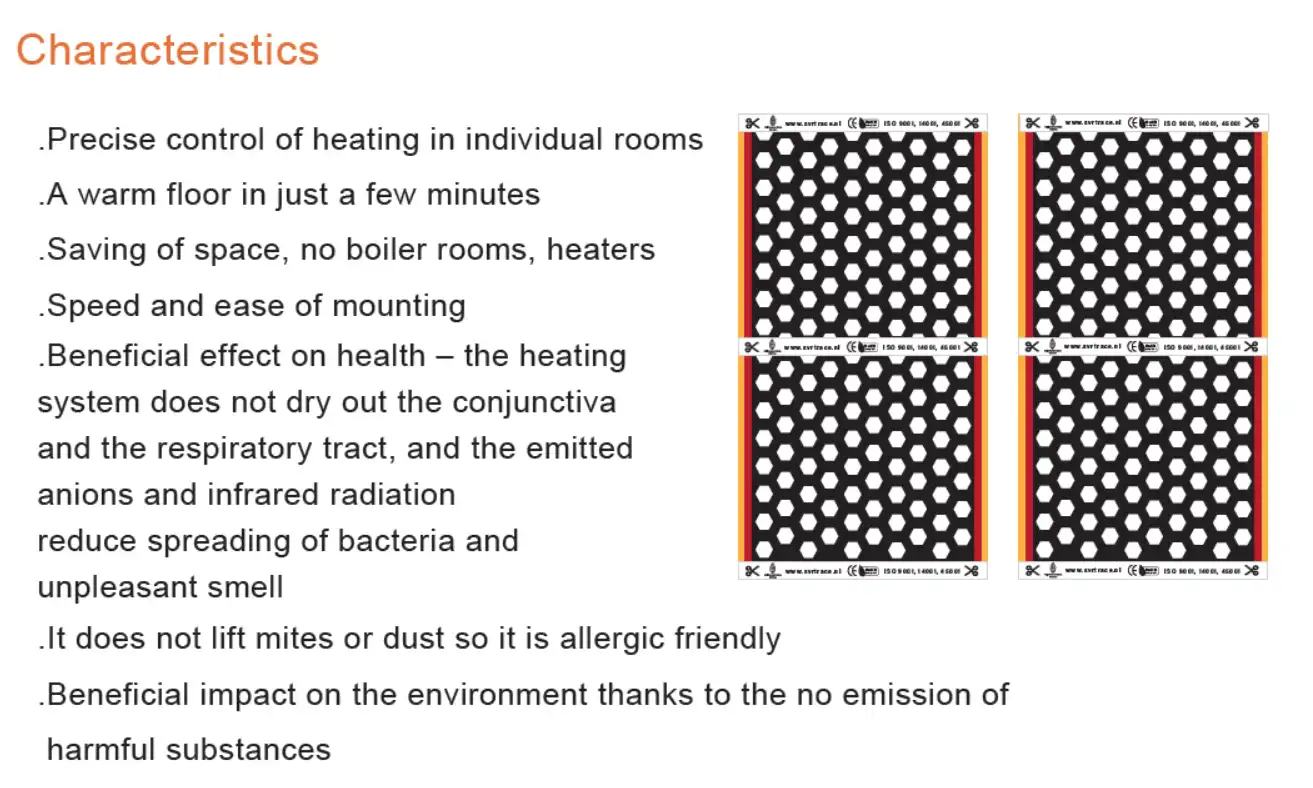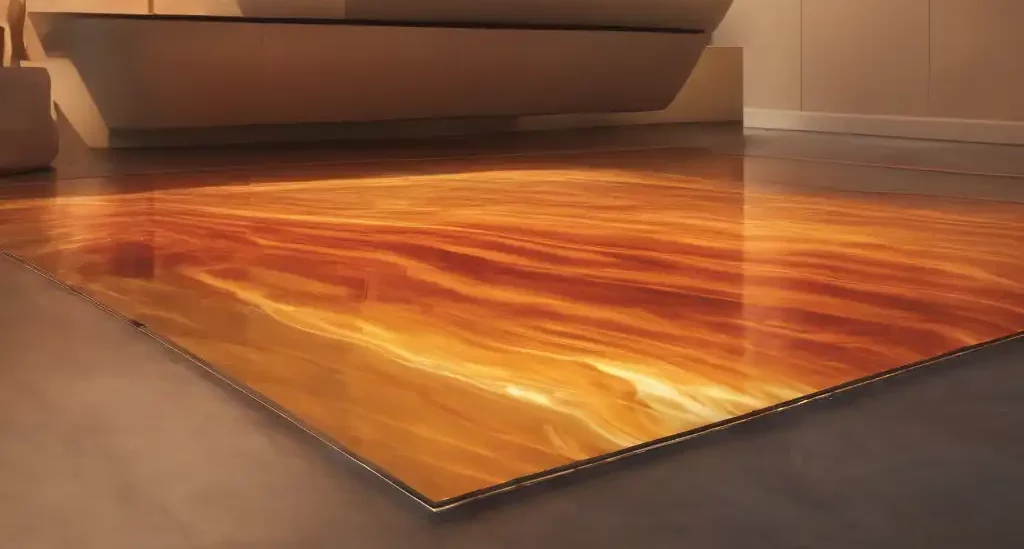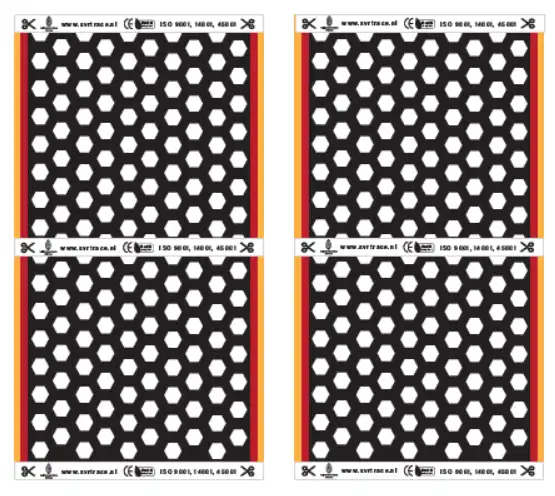Description
Underfloor heating film, also known as electric radiant floor heating film, is a modern and efficient way to heat a room from the floor up. It consists of a thin, flexible heating element that is installed directly beneath the floor covering, such as tile, laminate, or engineered wood. This type of heating system is gaining popularity due to its energy efficiency, comfort, and ease of installation.
The underfloor heating film is typically made of a conductive polymer material that generates heat when an electrical current passes through it. The film is installed in strips or mats across the floor, covering the desired heating area. It can be cut to fit any room size or shape, making it a versatile heating solution for both new construction and remodeling projects.
One of the key benefits of underfloor heating film is its ability to provide consistent and even heat distribution throughout the room. Unlike traditional forced-air heating systems, which often create hot and cold spots, radiant floor heating warms the entire floor surface, creating a comfortable environment from floor to ceiling. This radiant heat also has the added benefit of reducing heat loss through convection, resulting in lower energy consumption and utility bills.
Another advantage of underfloor heating film is its rapid response time. Because the heating element is located directly beneath the floor covering, it can quickly warm up the room when turned on, providing near-instant comfort. This is particularly beneficial in rooms with high ceilings or large windows, where traditional heating systems may struggle to maintain a consistent temperature.
In addition to its energy efficiency and comfort benefits, underfloor heating film is also relatively easy to install. Unlike hydronic radiant floor heating systems, which require extensive plumbing work and a dedicated boiler, electric radiant floor heating can be installed by homeowners or professionals with basic electrical skills. The film is simply laid out on the subfloor, connected to a thermostat and power source, and covered with the chosen flooring material.

Furthermore, underfloor heating film is compatible with a wide range of floor coverings, including tile, stone, laminate, hardwood, and carpet. This versatility allows homeowners to achieve their desired aesthetic without sacrificing comfort or efficiency. Additionally, because the heating element is hidden beneath the floor, underfloor heating film eliminates the need for bulky radiators or ductwork, freeing up valuable wall and floor space.
Maintenance requirements for underfloor heating film are minimal, making it a hassle-free heating solution for homeowners. Once installed, the system typically requires little to no servicing, aside from occasional cleaning to remove dust or debris. With proper care, underfloor heating film can provide reliable warmth for many years to come.
In conclusion, underfloor heating film is a modern and efficient heating solution that offers numerous benefits for homeowners. From its energy efficiency and comfort to its ease of installation and low maintenance requirements, this innovative heating system is becoming increasingly popular in residential and commercial applications alike. Whether used as a primary heat source or supplemental heating option, underfloor heating film provides consistent warmth and comfort, making it a valuable investment for any home.
Where can you use an underfloor heating film?

Underfloor heating film offers versatility in its applications, making it suitable for various spaces within both residential and commercial buildings. Its flexibility, efficiency, and comfort make it an attractive heating solution for a wide range of environments.
In residential settings, underfloor heating film can be used in virtually any room of the house. Here are some common areas where it can be installed:
1. Living Rooms and Bedrooms: Underfloor heating film provides cozy warmth underfoot in living areas and bedrooms, creating a comfortable environment for relaxation and socializing.
2. Bathrooms: Radiant floor heating film is particularly popular in bathrooms, where cold tile floors can be unpleasant, especially during colder months. Warm floors not only add comfort but also help to dry out wet areas more quickly, reducing the risk of slips and falls.
3. Kitchens: In kitchens, where people often spend a lot of time standing, underfloor heating film can help alleviate foot fatigue and provide consistent warmth while cooking or entertaining.
4. Basements: Basements are notorious for being chilly and damp, but underfloor heating film can help transform these spaces into comfortable living areas. Whether used as a primary heating source or supplemental warmth, radiant floor heating can make basements more inviting and usable year-round.
5. Home Offices: For those who work from home, a warm and comfortable workspace is essential. Underfloor heating film can create a cozy atmosphere in home offices, helping to increase productivity and overall well-being.
6. Nurseries and Children’s Rooms: Keeping little ones comfortable and safe is a priority for parents, and underfloor heating film can help achieve both. With its gentle warmth and even heat distribution, radiant floor heating provides a cozy environment for babies and young children to play and sleep.
In commercial buildings, underfloor heating film can also be utilized in various spaces to enhance comfort and efficiency:
1. Retail Stores: Warm floors can create a welcoming atmosphere for shoppers, encouraging them to linger longer and browse more comfortably. Underfloor heating film can be installed beneath retail floors to provide discreet, effective heating.
2. Offices: In office buildings, underfloor heating film can be used to supplement existing HVAC systems or as a primary heating source in individual workspaces. Comfortable employees are often more productive, making radiant floor heating a valuable investment for businesses.
3. Hotels and Hospitality: Hotels and resorts can benefit from the added luxury of underfloor heating film in guest rooms, bathrooms, spas, and common areas. Warm floors provide an extra touch of comfort and relaxation for guests, enhancing their overall experience.
4. Healthcare Facilities: In hospitals, clinics, and long-term care facilities, maintaining a comfortable temperature is crucial for patient comfort and recovery. Underfloor heating film can be installed in patient rooms, waiting areas, and therapy spaces to provide gentle, soothing warmth.
5. Educational Institutions: Schools and universities can create more comfortable learning environments by installing underfloor heating film in classrooms, libraries, and student lounges. Warm floors can help students stay focused and engaged, especially during colder months.
Overall, underfloor heating film can be used in a variety of residential and commercial settings to provide efficient, comfortable warmth where it’s needed most. Its versatility, energy efficiency, and low maintenance requirements make it a practical heating solution for modern buildings of all types and sizes.
Why should you choose an underfloor heating film over other systems?

Choosing an underfloor heating film over other heating systems offers numerous advantages that make it a compelling option for residential and commercial spaces alike. Here are several reasons why underfloor heating film stands out:
1. Efficiency: Underfloor heating film is highly efficient in converting electricity into heat. Unlike traditional forced-air systems, which can lose heat through ductwork or radiators, radiant floor heating delivers warmth directly from the floor up, minimizing energy waste. This efficiency can lead to lower energy bills and reduced environmental impact over time.
2. Comfort: Radiant floor heating provides consistent, even warmth throughout the room, creating a comfortable environment from floor to ceiling. Unlike forced-air systems that can create drafts or hot and cold spots, underfloor heating film eliminates temperature variations, ensuring a cozy atmosphere in every corner of the space. Additionally, radiant heat feels gentle and soothing on the skin, making it an ideal choice for homes and businesses.
3. Space-saving Design: Underfloor heating film is installed beneath the floor covering, eliminating the need for bulky radiators, baseboard heaters, or ductwork. This space-saving design frees up valuable wall and floor space, allowing for greater flexibility in room layout and interior design. Without visible heating elements, underfloor heating film offers a clean, unobtrusive heating solution that seamlessly integrates with any decor.
4. Versatility: Underfloor heating film is compatible with a wide range of floor coverings, including tile, laminate, hardwood, carpet, and vinyl. This versatility allows homeowners and designers to choose their preferred flooring materials without compromising on comfort or efficiency. Whether renovating an existing space or building a new home, underfloor heating film can accommodate virtually any flooring type, making it a versatile heating solution for diverse environments.
5. Quiet Operation: Unlike forced-air systems that can produce noise as air moves through ducts or vents, underfloor heating film operates silently, creating a peaceful environment free from distracting sounds. This quiet operation is especially beneficial in bedrooms, offices, and other quiet spaces where noise reduction is desired.
6. Low Maintenance: Underfloor heating film requires minimal maintenance once installed. Unlike boilers or furnaces that require regular servicing, radiant floor heating systems have few moving parts and typically only require occasional cleaning to remove dust or debris. With proper care, underfloor heating film can provide reliable warmth for many years without the need for extensive maintenance or repairs.
7. Quick Installation: Installing underfloor heating film is relatively quick and straightforward compared to other heating systems. The film is simply laid out on the subfloor, connected to a thermostat and power source, and covered with the chosen flooring material. This streamlined installation process minimizes disruption to the home or building occupants and allows for faster completion of construction or renovation projects.
In summary, underfloor heating film offers numerous benefits over other heating systems, including efficiency, comfort, space-saving design, versatility, quiet operation, low maintenance, and quick installation. Whether used in residential or commercial settings, radiant floor heating provides an ideal combination of warmth, convenience, and energy efficiency, making it a preferred choice for modern buildings.
Why should you choose SVR Trace for purchasing an underfloor heating film?

Choosing SVR Trace for purchasing an underfloor heating film offers several compelling reasons that make it an excellent choice for homeowners, contractors, and businesses alike. Here are some key factors to consider:
1. Quality Products: SVR Trace is known for providing high-quality underfloor heating film products that are reliable, durable, and efficient. Their heating films are manufactured using advanced technologies and top-grade materials, ensuring consistent performance and long-term durability. With SVR Trace, customers can trust that they are investing in a heating solution that will deliver reliable warmth and comfort for years to come.
2. Wide Range of Options: SVR Trace offers a wide range of underfloor heating film options to suit various needs and preferences. Whether customers are looking for a heating solution for a small bathroom or a large living area, SVR Trace has products available in different sizes, wattages, and configurations to accommodate any space. Additionally, their heating films are compatible with various floor coverings, allowing customers to choose the flooring material that best suits their style and design preferences.
3. Expertise and Support: SVR Trace has a team of knowledgeable experts who can provide guidance and support throughout the purchasing process. Whether customers have questions about product selection, installation, or troubleshooting, SVR Trace’s experienced staff is available to offer assistance and ensure a smooth and successful experience. From initial inquiries to post-purchase support, customers can rely on SVR Trace to provide helpful and responsive service every step of the way.
4. Competitive Pricing: Despite offering high-quality products and excellent service, SVR Trace maintains competitive pricing to ensure affordability for customers. Their underfloor heating film solutions are priced competitively compared to other brands on the market, making them a cost-effective option for homeowners, contractors, and businesses looking to invest in radiant floor heating. With SVR Trace, customers can enjoy the benefits of premium-quality heating products without breaking the bank.
5. Reliability and Trustworthiness: SVR Trace has built a reputation for reliability and trustworthiness in the industry. Customers can have confidence in the quality and performance of SVR Trace’s products, knowing that they are backed by a company with a track record of delivering exceptional heating solutions. Whether for residential or commercial applications, SVR Trace’s underfloor heating films are trusted by homeowners, contractors, and businesses alike to provide reliable warmth and comfort.
6. Commitment to Customer Satisfaction: Above all, SVR Trace is committed to customer satisfaction. They prioritize the needs and preferences of their customers and strive to exceed expectations with every interaction. Whether it’s providing personalized recommendations, ensuring timely delivery, or offering ongoing support, SVR Trace goes above and beyond to ensure that customers are satisfied with their underfloor heating film purchase.
In conclusion, choosing SVR Trace for purchasing an underfloor heating film offers numerous benefits, including quality products, a wide range of options, expertise and support, competitive pricing, reliability and trustworthiness, and a commitment to customer satisfaction. Whether for residential or commercial applications, SVR Trace is a trusted partner for all heating needs, providing reliable warmth, comfort, and peace of mind.
What material is used for an underfloor heating film?

Underfloor heating films utilize a specialized material known as a conductive polymer to generate and distribute heat efficiently. This conductive polymer material is engineered to possess specific electrical and thermal properties that make it well-suited for use in radiant floor heating systems.
The primary component of the conductive polymer material used in underfloor heating films is typically carbon. Carbon is chosen for its excellent conductivity, allowing it to efficiently transfer electrical energy into heat. Additionally, carbon is highly stable and durable, making it suitable for use in heating applications where reliability and longevity are essential.
In addition to carbon, the conductive polymer material may also contain other additives and fillers to enhance its performance and properties. These additives may include metals, ceramics, or other conductive materials that help improve heat distribution and thermal stability.
The conductive polymer material used in underfloor heating films is engineered to be thin and flexible, allowing it to be easily installed beneath various types of flooring materials. This flexibility enables the heating film to conform to the contours of the floor and provide uniform heat distribution across the entire surface area.
One of the key advantages of using a conductive polymer material for underfloor heating films is its ability to heat up quickly and respond rapidly to changes in temperature. This rapid response time ensures that the heating system can adjust quickly to heating demands, providing near-instant comfort when needed.
Furthermore, the conductive polymer material used in underfloor heating films is designed to be highly efficient in converting electrical energy into heat. This efficiency helps minimize energy consumption and reduces operating costs compared to traditional heating systems.
Another important characteristic of the conductive polymer material is its safety profile. Underfloor heating films are engineered to meet stringent safety standards and regulations, ensuring that they can be used safely in residential and commercial environments. The conductive polymer material is non-toxic and non-reactive, and it poses no risk of fire or electric shock when installed and operated correctly.
Overall, the conductive polymer material used in underfloor heating films plays a crucial role in the performance, efficiency, and safety of these heating systems. Its unique properties allow for rapid heat generation, uniform heat distribution, and reliable operation, making underfloor heating films a popular choice for providing efficient and comfortable warmth in homes and buildings.
Underfloor heating film price

The cost of underfloor heating film can vary depending on several factors, including the size of the heating area, the type of film, installation requirements, and additional accessories or features. Understanding the pricing factors can help homeowners and contractors make informed decisions when purchasing underfloor heating film for their projects.
One of the primary factors influencing the price of underfloor heating film is the size of the heating area. Generally, larger heating areas require more heating film and additional components, such as thermostats and wiring, which can increase the overall cost. Conversely, smaller heating areas may require less material and fewer accessories, resulting in lower overall costs.
The type of underfloor heating film chosen can also impact the price. Basic heating films with standard features and lower wattages may be more affordable compared to premium models with advanced features, higher wattages, or additional insulation layers for improved energy efficiency. While premium models may have a higher upfront cost, they may offer long-term energy savings and superior performance, making them a worthwhile investment for some homeowners.
Installation requirements can also affect the price of underfloor heating film. If professional installation is required, homeowners should budget for labor costs in addition to the cost of the heating film itself. Installation costs can vary depending on factors such as the complexity of the installation, the accessibility of the heating area, and local labor rates. DIY installation may be an option for some homeowners, potentially saving on labor costs, but it’s essential to ensure proper installation to avoid damage or safety issues.
In addition to the heating film itself, homeowners should consider the cost of accessories and additional components needed for the system, such as thermostats, sensors, and wiring. These accessories can add to the overall cost but are essential for proper operation and control of the underfloor heating system. It’s essential to factor in the cost of these accessories when budgeting for an underfloor heating project.
When comparing prices for underfloor heating film, homeowners should also consider the long-term costs and benefits of the system. While underfloor heating film may have a higher upfront cost compared to other heating systems, such as baseboard heaters or radiators, it can offer significant energy savings over time. Radiant floor heating is known for its energy efficiency and ability to provide consistent, comfortable warmth, which can result in lower heating bills and increased home comfort in the long run.
Furthermore, homeowners should consider the overall value provided by underfloor heating film compared to other heating options. While the upfront cost may be higher, underfloor heating film offers benefits such as space-saving design, quiet operation, and even heat distribution, which can enhance the overall comfort and enjoyment of the home. Additionally, underfloor heating film may increase the resale value of the home, making it a worthwhile investment for homeowners looking to improve their property.
In conclusion, the price of underfloor heating film can vary depending on factors such as the size of the heating area, the type of film chosen, installation requirements, and additional accessories. While the upfront cost of underfloor heating film may be higher compared to other heating options, it offers numerous benefits such as energy efficiency, comfort, and long-term savings. By considering these factors and weighing the costs and benefits, homeowners can make informed decisions when purchasing underfloor heating film for their projects.
Underfloor heating film installation

Underfloor heating film installation is a straightforward process that can be completed by homeowners or professionals with basic electrical and flooring installation skills. This innovative heating system offers efficient and comfortable warmth from the floor up, making it an attractive option for new construction projects, renovations, and upgrades. Here’s a comprehensive guide to underfloor heating film installation:
1. Preparation: Before beginning the installation process, it’s essential to ensure that the subfloor is clean, dry, and level. Any debris, dust, or moisture should be removed to create a smooth and stable surface for the heating film.
2. Layout Planning: Determine the layout of the underfloor heating film based on the dimensions and shape of the room. Measure the area where the heating film will be installed and plan the layout accordingly, taking into account any obstacles such as furniture or fixtures.
3. Cutting the Heating Film: Underfloor heating films are typically supplied in rolls or sheets that can be easily cut to size. Using scissors or a utility knife, carefully cut the heating film to fit the dimensions of the room, ensuring that it covers the entire heating area evenly.
4. Positioning the Heating Film: Lay out the cut pieces of heating film on the subfloor, positioning them according to the planned layout. Avoid overlapping or folding the heating film, as this can create uneven heat distribution and potential hotspots.
5. Securing the Heating Film: Once the heating film is positioned correctly, secure it to the subfloor using double-sided adhesive tape or specialized fixing strips. Ensure that the heating film is flat and smooth against the subfloor to prevent any air pockets or wrinkles that could affect its performance.
6. Electrical Connections: Connect the heating film to the power supply using appropriate electrical connections. Follow the manufacturer’s instructions carefully to ensure that the connections are made correctly and safely. It’s recommended to use a qualified electrician to make these connections if you’re not familiar with electrical work.
7. Insulation: For optimal efficiency, consider installing insulation beneath the heating film to minimize heat loss downward. Insulation boards or reflective foil insulation can help enhance the performance of the underfloor heating system and reduce energy consumption.
8. Floor Covering Installation: Once the heating film is installed and connected, the final step is to install the chosen floor covering material. Underfloor heating films are compatible with a wide range of flooring options, including tile, laminate, hardwood, carpet, and vinyl. Follow the manufacturer’s guidelines for installing the floor covering to ensure compatibility with the heating system.
9. Testing and Commissioning: Before using the underfloor heating system, it’s essential to test and commission it to ensure proper operation and safety. Turn on the system and monitor the heating film to verify that it reaches the desired temperature evenly across the floor. Make any necessary adjustments or repairs as needed to address any issues before completing the installation.
10. User Instructions: Finally, provide the homeowner or end-user with clear instructions on how to operate and maintain the underfloor heating system. Advise them on proper usage, temperature settings, and maintenance procedures to ensure the long-term performance and reliability of the system.
In conclusion, underfloor heating film installation is a relatively simple process that can be completed with careful planning and attention to detail. By following these steps and consulting with professionals as needed, homeowners can enjoy the benefits of efficient and comfortable warmth from their radiant floor heating system for years to come.
Infrared underfloor heating film

Infrared underfloor heating film represents a modern and innovative approach to heating spaces, offering numerous advantages over traditional heating systems. This type of heating utilizes infrared radiation to deliver efficient and comfortable warmth from the floor up, providing a host of benefits for residential and commercial applications.
At the heart of infrared underfloor heating film is a series of ultra-thin, carbon-based heating elements embedded within a flexible polymer film. These elements emit infrared radiation when an electrical current passes through them, effectively heating the floor surface and surrounding objects in the room. Unlike traditional convection heating systems, which heat the air directly, infrared heating warms objects and surfaces, creating a more comfortable and consistent indoor environment.
One of the key advantages of infrared underfloor heating film is its efficiency. Because infrared radiation heats objects directly, rather than the air, it can achieve the desired level of warmth more quickly and with less energy consumption. This efficiency not only reduces heating costs but also minimizes heat loss through convection, resulting in a more sustainable and eco-friendly heating solution.
Additionally, infrared underfloor heating film offers rapid response times, allowing it to adjust quickly to changes in temperature or heating demands. This means that occupants can enjoy near-instantaneous warmth when the heating system is turned on, enhancing comfort and convenience.
Another benefit of infrared underfloor heating film is its ability to provide even heat distribution across the entire floor surface. Unlike traditional heating systems, which may create hot and cold spots, infrared heating delivers consistent warmth from wall to wall, ensuring a comfortable environment throughout the room.
Infrared underfloor heating film is also compatible with a wide range of flooring materials, including tile, laminate, hardwood, and carpet. This versatility allows homeowners and designers to choose their preferred flooring without sacrificing the benefits of radiant floor heating. Whether renovating an existing space or building a new home, infrared heating film can accommodate virtually any flooring type, making it a versatile and adaptable heating solution.
Furthermore, infrared underfloor heating film is discreet and unobtrusive, with minimal visual impact on the room’s aesthetics. Because the heating elements are embedded within the floor, there are no visible radiators, baseboards, or vents, allowing for greater design freedom and flexibility.
In terms of installation, infrared underfloor heating film is relatively simple and straightforward. The film is typically installed directly onto the subfloor, either as a loose-laid mat or secured with adhesive, depending on the application. Once installed, the heating film is connected to a thermostat and power source, allowing for precise temperature control and energy-efficient operation.
Maintenance requirements for infrared underfloor heating film are minimal, making it a hassle-free heating solution for homeowners and building managers. With proper care and periodic inspections, infrared heating film can provide reliable warmth for many years without the need for extensive maintenance or repairs.
Overall, infrared underfloor heating film offers numerous benefits, including efficiency, comfort, even heat distribution, compatibility with various flooring materials, discreet installation, and low maintenance requirements. Whether used in residential or commercial settings, infrared heating film provides a modern, efficient, and comfortable heating solution that enhances the indoor environment and improves overall quality of life.
Carbon underfloor heating film
Carbon underfloor heating film is a cutting-edge heating solution that utilizes the exceptional conductivity of carbon to efficiently and evenly distribute warmth throughout a room. This innovative technology has revolutionized the way homes and buildings are heated, offering numerous advantages over traditional heating systems. Here’s a closer look at carbon underfloor heating film and its benefits:
1. Exceptional Conductivity: Carbon is renowned for its excellent electrical conductivity, making it an ideal material for underfloor heating applications. In carbon underfloor heating film, carbon particles are dispersed within a polymer matrix, forming a conductive layer that efficiently transfers electrical energy into heat. This conductivity allows the heating film to generate warmth quickly and evenly across the entire floor surface.
2. Thin and Flexible Design: Carbon underfloor heating film is engineered to be thin and flexible, allowing it to be easily installed beneath various types of flooring materials. Unlike bulky radiators or ductwork, the heating film is virtually invisible once installed, providing a clean and unobtrusive heating solution. Its flexibility also enables the heating film to conform to the contours of the floor, ensuring uniform heat distribution without any cold spots.
3. Rapid Heat Response: One of the key advantages of carbon underfloor heating film is its rapid heat response time. Unlike traditional heating systems that may take time to warm up, the heating film can quickly reach the desired temperature, providing near-instant comfort when needed. This rapid response time allows for precise control over room temperature, reducing energy waste and optimizing energy efficiency.
4. Energy Efficiency: Carbon underfloor heating film is highly energy-efficient, converting electrical energy into heat with minimal loss. The conductivity of carbon ensures that heat is evenly distributed across the entire floor surface, eliminating the need for additional heating sources or energy-consuming appliances. By providing consistent warmth from the floor up, the heating film helps reduce heat loss through convection and radiation, resulting in lower energy consumption and utility bills.
5. Silent Operation: Unlike forced-air heating systems that can produce noise as air circulates through ducts or vents, carbon underfloor heating film operates silently, creating a quiet and comfortable environment. This is particularly beneficial in bedrooms, offices, and other quiet spaces where noise reduction is desired. With carbon underfloor heating film, occupants can enjoy peaceful surroundings without the distraction of heating-related noises.
6. Low Maintenance: Carbon underfloor heating film requires minimal maintenance once installed. Unlike boilers or furnaces that require regular servicing, the heating film has few moving parts and typically only requires occasional cleaning to remove dust or debris. This low maintenance requirement makes carbon underfloor heating film a hassle-free heating solution for homeowners and building managers.
7. Safety: Carbon underfloor heating film is designed with safety in mind. The heating elements are embedded within a durable polymer matrix, ensuring that they are well-protected from damage or wear. Additionally, the heating film is engineered to meet stringent safety standards and regulations, providing peace of mind to homeowners and building occupants.
In conclusion, carbon underfloor heating film offers a range of benefits, including exceptional conductivity, thin and flexible design, rapid heat response, energy efficiency, silent operation, low maintenance, and safety. With its advanced technology and numerous advantages, carbon underfloor heating film is a reliable and cost-effective heating solution for homes, offices, and commercial buildings.


Reviews
There are no reviews yet.